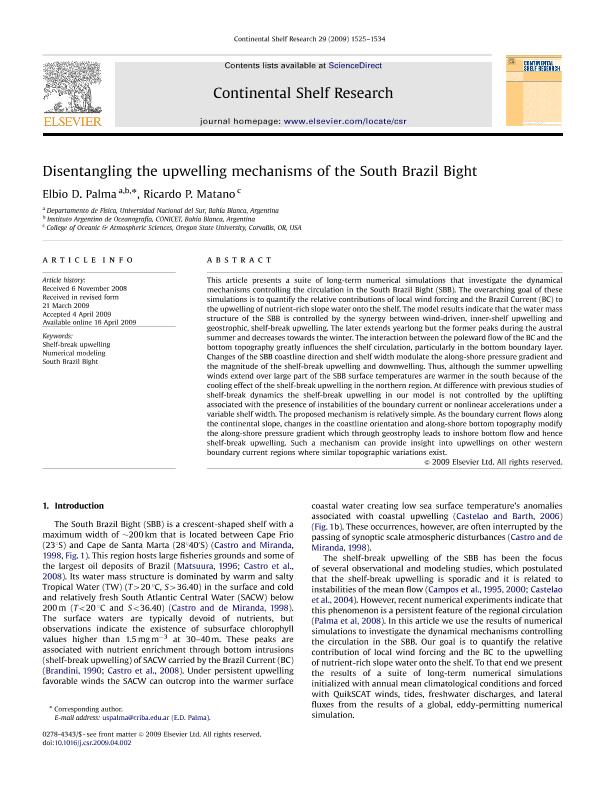Artículo
Disentangling the upwelling mechanisms of the South Brazil Bight
Fecha de publicación:
04/2009
Editorial:
Elsevier
Revista:
Continental Shelf Research
ISSN:
0278-4343
e-ISSN:
1873-6955
Idioma:
Inglés
Tipo de recurso:
Artículo publicado
Clasificación temática:
Resumen
This article presents a suite of long-term numerical simulations that investigate the dynamical mechanisms controlling the circulation in the South Brazil Bight (SBB). The overarching goal of these simulations is to quantify the relative contributions of local wind forcing and the Brazil Current (BC) to the upwelling of nutrient-rich slope water onto the shelf. The model results indicate that the water mass structure of the SBB is controlled by the synergy between wind-driven, inner-shelf upwelling and geostrophic, shelf-break upwelling. The later extends yearlong but the former peaks during the austral summer and decreases towards the winter. The interaction between the poleward flow of the BC and the bottom topography greatly influences the shelf circulation, particularly in the bottom boundary layer. Changes of the SBB coastline direction and shelf width modulate the along-shore pressure gradient and the magnitude of the shelf-break upwelling and downwelling. Thus, although the summer upwelling winds extend over large part of the SBB surface temperatures are warmer in the south because of the cooling effect of the shelf-break upwelling in the northern region. At difference with previous studies of shelf-break dynamics the shelf-break upwelling in our model is not controlled by the uplifting associated with the presence of instabilities of the boundary current or nonlinear accelerations under a variable shelf width. The proposed mechanism is relatively simple. As the boundary current flows along the continental slope, changes in the coastline orientation and along-shore bottom topography modify the along-shore pressure gradient which through geostrophy leads to inshore bottom flow and hence shelf-break upwelling. Such a mechanism can provide insight into upwellings on other western boundary current regions where similar topographic variations exist.
Palabras clave:
Oceanografia
Archivos asociados
Licencia
Identificadores
Colecciones
Articulos(IADO)
Articulos de INST.ARG.DE OCEANOGRAFIA (I)
Articulos de INST.ARG.DE OCEANOGRAFIA (I)
Citación
Palma, Elbio Daniel; Matano, Ricardo; Disentangling the upwelling mechanisms of the South Brazil Bight; Elsevier; Continental Shelf Research; 29; 11-12; 4-2009; 1525-1534
Compartir
Altmétricas




